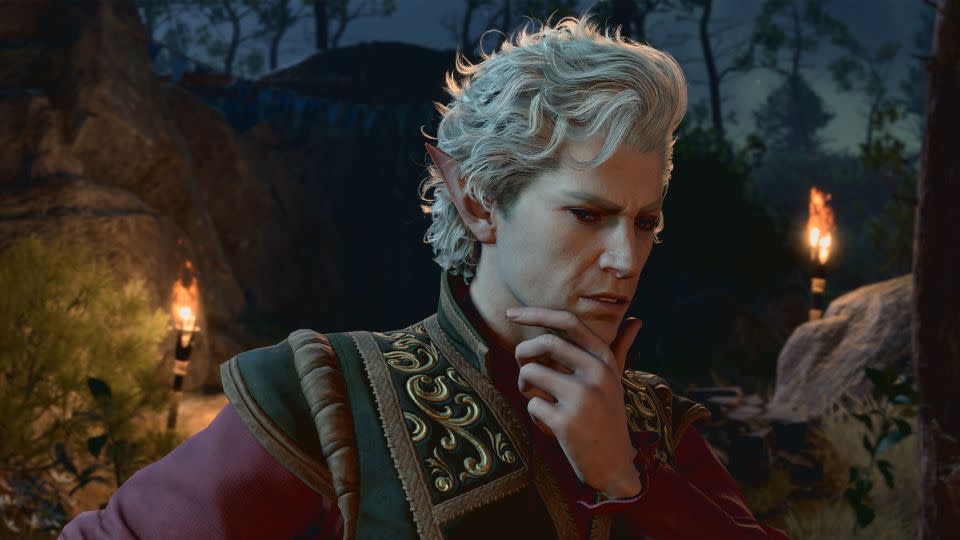A video game vampire has captured the hearts of many

In “Baldur’s Gate 3,” a massive video game set in the world of “Dungeons & Dragons”, winged beasts have nothing on one devilishly handsome vampire.
Astarion, a silver-haired vampire with a jawline that could cut glass and a propensity for even more cutting verbal takedowns, is an integral member of a player’s “party” and sardonic foil to self-serious wizards, warlocks, clerics and other standard D&D characters. But many players care more about what happens between quests — attempting to win Astarion’s cold, undead heart.
“Baldur’s Gate 3” players can woo Astarion throughout the game, and hundreds of thousands of them have tried — and failed. But even those who can’t successfully romance the bloodsucker have fallen for him anyway — he’s inspired TikTok homages that have been viewed over 600 million times, fan-made artwork on Tumblr and, like many vamps before him, steamy Wattpad fan fiction.
“On my honor,” Astarion says with feigned seriousness, “the only thing on my mind is depraved carnal lust.” That line alone has spawned dozens of fan videos.
Astarion is a clever, mercurial charmer, but he’s also a rogue elf who lived much of his eternal life as a slave and became a bloodsucker against his will. His casual coldness, players realize, is his defense against feeling anything too deeply. It’s enough to make them think, “I can fix him.”
Rachel Stewart has tried, even playing the game twice through to win his affections. During her first playthrough of the game, Astarion didn’t care for her “neutral good” campaign style and rejected her. So on her second go-round, Stewart, a Victorian literary historicist at Ohio State University who’s extensively studied vampire fiction, crafted the perfect mate for Astarion — a semi-chaotic dark elf sorcerer with whom the vamp shares a much stronger connection.
“Whether you want to marry Astarion, be his therapist, project your own issues onto him, or merely wallow in the angst, he’s got you covered,” Stewart told CNN.
It’s not easy to win his affections
Players have a veritable buffet of potential romantic partners in “Baldur’s Gate 3,” but Astarion is perhaps the most charismatic — and objectively gorgeous.
“Let’s get the obvious out of the way — he’s hot!” Stewart said.
And yet, his approval may be hardest to win. The character, colorfully voiced by Neil Newbon, is such a desirable beau that fans have authored step-by-step guides on how to earn his approval and reach coveted “intimate scenes.”
Prying his heart open can take dozens of hours of gameplay, and one wrong response can turn Astarion off for good. Nearly 100,000 players were rejected by Astarion in the opening weekend alone, per Larian Studios, which released the game. It’s given players all the more reason to return to the game and try their luck with Astarion again.
And even if players do get there, there’s no guarantee Astarion will stick around: “Ugh,” he’ll yowl. “Five seconds into this relationship and I already want to break up with you.”
Vampires like Astarion are endlessly compelling
Stewart said Astarion is a near-perfect example of a “Byronic vampire,” based on the 19th-century poet Lord Byron, known for being “beautiful, flirty but constantly moody and a jerk to most people.”
The modern vampires with whom fans have fallen in love tend to follow a similar model: They’re often gorgeous and shamelessly sexual, but they’re secretly tortured, too, and deeply devoted to those to whom they open up, Stewart said. Before Astarion, there were Louis and Lestat of Anne Rice’s “Vampire Chronicles,” “Twilight’s” Edward Cullen and Damon Salvatore of “The Vampire Diaries,” to name a few vamps with which Astarion shares his most endearing traits.
“The allure of the Byronic vampire comes with the sympathetic quality to them — that they struggle with their own status as ‘monster’ and have a heart underneath all that blood,” Stewart said.
Some players have already brought the best out of Astarion: “I am capable of doing the right thing from … time to time,” he quips in one scenario.
Vamps — they’re just like us!
When they’re not dream-partner material, they can be our stand-ins, too. Their experiences often represent a fantastical, distorted version of our own, Stewart said.
Astarion may be an especially meaningful character to players who’ve felt subjugated or abused: It was never his choice to become a vampire, Stewart noted, and the lack of control that defined so much of his eternal life shaped who he became even after he was freed.
“Choice is something that seems to be getting stripped away from us more and more each day, so his struggles feel especially topical,” she said.
Creators of vampire fiction have also used vampirism as a metaphor for addiction or sexuality, and many vampires experience alienation or discrimination because of their “abnormal consumption habits,” Stewart said. They often spend their existences reconciling their dark nature with their more human qualities — psychological wrestling that even some humans do.
“Their popularity comes down to our increasing willingness to identify with the monster itself,” Stewart said. “It’s a dangerously dark fantasy to want to be the one to help the vampire fight their inner demons, but it’s also a reality for many people who also struggle with their own darkness and it’s affirming to see our own complex monstrosities depicted in fiction.”
Whether Astarion leans all the way into his inner darkness or overcomes his more violent urges through the power of love is for players to discover. At the very least, they can pray that he offers them a cuddle.
For more CNN news and newsletters create an account at CNN.com

